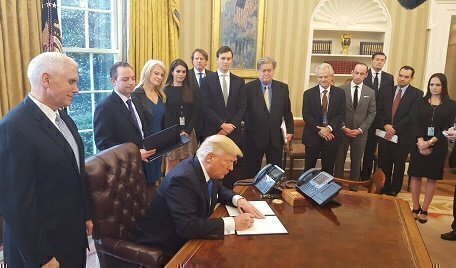The Trump Administration has vowed to return swiftly to the Supreme Court if a federal judge relaxes, in any way, the government's restrictions on entry into the U.S. of foreign nationals and refugees. In a filing Monday in a federal trial court in Hawaii, Justice Department lawyers argued that the challengers to current regulations under a presidential executive order on immigration are not legally entitled to any changes at all.
 If there is a return to the Supreme Court, it would be to get clarification of what the Justices meant on June 26 in allowing limited enforcement of President Trump's March 6 order suspending entry of foreign nationals of six Mideast nations and refugees from anywhere in the world.
If there is a return to the Supreme Court, it would be to get clarification of what the Justices meant on June 26 in allowing limited enforcement of President Trump's March 6 order suspending entry of foreign nationals of six Mideast nations and refugees from anywhere in the world.
The court ruled that the government may not enforce the entry restrictions against any foreign individuals who “have a credible claim to a bona fide relationship with a person or entity in the United States.” An individual must show “a close family relationship,” the court said. If the link is with an organization in the U.S., the court required a relationship that is “formal, documented, and formed in the ordinary course.” The court did not further define any of the terms.
Before the Administration actually began enforcing the suspensions the court had allowed, the state of Hawaii and the imam of a mosque in Hawaii filed a new challenge with a federal trial judge in Honolulu, challenging information they then had as to how the government planned to define the terms in the court’s opinion. It was going to exclude too many individuals with family ties in the U.S., and too many refugees who had made arrangements with resettlement agencies to come to the U.S., they claimed.
That challenge was soon joined by a refugee resettlement group and a legal advocacy group for refugees, claiming that the government was going too far to exclude too many refugees.
When enforcement actually began, and with one change quickly made, these are the people the government decided would be allowed entry among those with family ties: parent (including in-laws), spouse, fiancé, child, adult son or daughter, son-in-law, daughter-in-law, sibling or half-sibling, and step relationships.
But, the government concluded, the Supreme Court ruling allowed it to keep out these people: grandparents, grandchildren, aunts, uncles, nieces, nephews, cousins, brothers-in-law, sisters-in-law and any ‘extended’ family members. As for refugees, the government decided it would not be sufficient for an applicant for that status simply to have signed up with a resettlement agency, and it gave consular officers discretion to decide who qualified as a refugee.
The challengers protested those exclusions, contending that the Supreme Court had meant to allow the government to keep out only persons who had “no connection at all” to the U.S. As to refugees, the challengers argued that the Justices meant to allow any refugee who had an arrangement with a settlement agency or with a refugee legal aid group.
In their formal motion to clarify, the challengers asked U.S. District Judge Derrick K. Watson of Honolulu to interpret the Supreme Court opinion to include all of those with the family ties that the government was excluding. They argued that those are foreigners “who have some of the most elemental relationships known to human society, from grandparents to nephews.” And they argued that the judge should clarify that refugees with signed documents of arrangements for resettlement or legal aid had a sufficient link to the U.S.
In its formal response filed Monday, the Administration argued that the family relationships it was excluding were those relationships that were given a different status in federal immigration laws. The exclusions put into effect exactly tracked categories already spelled out in immigration laws, the government filing contended.
On refugees, the government filing said an agreement on resettlement for a refugee is not something that a refugee personally has obtained. Rather, it said, it is an agreement between the government and the resettlement agency involved, and does not confer any right for the refugee to be admitted without further processing. Such agreements cannot be reinterpreted as the kind of documentary proof the Supreme Court had in mind, the federal filing asserted.
In addition, the filing argued that it was premature for refugees to be seeking entry on the basis of an agreement on legal representation by an advocacy group.
In short, the Administration document concluded, Judge Watson should order no changes whatsoever in the details that the government was now carrying out, and has been since the night of June 29. If, however, the judge grants “any relief” to the challengers, it added, “the government respectfully requests that the court stay that relief pending the filing by the government and disposition of an immediate request to the Supreme Court for clarification of its ruling.” (A “stay” is a postponement of a court action.)
The Supreme Court is now in recess for the summer months, but the Justices always have mechanisms for dealing with emergency applications of the kind the Administration lawyers were talking about. Although some of the Justices are traveling overseas, they can be reached by their secretaries, law clerks, and court staff members.
It would take a majority of the nine Justices to add new clarification or to overturn any relaxation that Judge Watson had ordered.
Legendary journalist Lyle Denniston is Constitution Daily’s Supreme Court correspondent. Denniston has written for us as a contributor since June 2011 and has covered the Supreme Court since 1958. His work also appears on lyldenlawnews.com.







